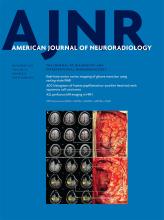Index by author
Cahalane, A.M.
- Head and Neck ImagingYou have accessThe Diagnostic Accuracy of Contrast-Enhanced CT of the Neck for the Investigation of SialolithiasisY.M. Purcell, R.G. Kavanagh, A.M. Cahalane, A.G. Carroll, S.G. Khoo and R.P. KilleenAmerican Journal of Neuroradiology November 2017, 38 (11) 2161-2166; DOI: https://doi.org/10.3174/ajnr.A5353
Calahan, C.F.
- Pediatric NeuroimagingYou have accessTransient Focal Neurologic Symptoms Correspond to Regional Cerebral Hypoperfusion by MRI: A Stroke Mimic in ChildrenL.L. Lehman, A.R. Danehy, C.C. Trenor, C.F. Calahan, M.E. Bernson-Leung, R.L. Robertson and M.J. RivkinAmerican Journal of Neuroradiology November 2017, 38 (11) 2199-2202; DOI: https://doi.org/10.3174/ajnr.A5296
Carroll, A.G.
- Head and Neck ImagingYou have accessThe Diagnostic Accuracy of Contrast-Enhanced CT of the Neck for the Investigation of SialolithiasisY.M. Purcell, R.G. Kavanagh, A.M. Cahalane, A.G. Carroll, S.G. Khoo and R.P. KilleenAmerican Journal of Neuroradiology November 2017, 38 (11) 2161-2166; DOI: https://doi.org/10.3174/ajnr.A5353
Cebral, J.R.
- EDITOR'S CHOICENeurointerventionOpen AccessAngioarchitectures and Hemodynamic Characteristics of Posterior Communicating Artery Aneurysms and Their Association with Rupture StatusB.J. Chung, R. Doddasomayajula, F. Mut, F. Detmer, M.B. Pritz, F. Hamzei-Sichani, W. Brinjikji, D.F. Kallmes, C.M. Jimenez, C.M. Putman and J.R. CebralAmerican Journal of Neuroradiology November 2017, 38 (11) 2111-2118; DOI: https://doi.org/10.3174/ajnr.A5358
The authors studied 313 posterior communicating artery aneurysms (145 ruptured, 168 unruptured) with image-based computational fluid dynamics. Aneurysms were classified into different angioarchitecture types depending on the location of the aneurysm with respect to parent artery bifurcation. Ruptured aneurysms had higher, more concentrated, and more oscillatory wall shear stress distributions; stronger and more concentrated inflow jets; and more complex and unstable flow patterns compared with unruptured aneurysms. They conclude that high-flow intrasaccular hemodynamic characteristics, commonly found in bifurcation-type angioarchitectures, are associated with the posterior communicating artery aneurysm rupture status.
Chabriat, H.
- Adult BrainOpen AccessReaction Time Is Negatively Associated with Corpus Callosum Area in the Early Stages of CADASILS. Delorme, F. De Guio, S. Reyes, A. Jabouley, H. Chabriat and E. JouventAmerican Journal of Neuroradiology November 2017, 38 (11) 2094-2099; DOI: https://doi.org/10.3174/ajnr.A5378
Chan, A.
- Adult BrainYou have accessDetection of Volume-Changing Metastatic Brain Tumors on Longitudinal MRI Using a Semiautomated Algorithm Based on the Jacobian Operator FieldO. Shearkhani, A. Khademi, A. Eilaghi, S.-P. Hojjat, S.P. Symons, C. Heyn, M. Machnowska, A. Chan, A. Sahgal and P.J. MaralaniAmerican Journal of Neuroradiology November 2017, 38 (11) 2059-2066; DOI: https://doi.org/10.3174/ajnr.A5352
Chang, S.D.
- NeurointerventionYou have accessPatient Outcomes and Cerebral Infarction after Ruptured Anterior Communicating Artery Aneurysm TreatmentJ.J. Heit, R.L. Ball, N.A. Telischak, H.M. Do, R.L. Dodd, G.K. Steinberg, S.D. Chang, M. Wintermark and M.P. MarksAmerican Journal of Neuroradiology November 2017, 38 (11) 2119-2125; DOI: https://doi.org/10.3174/ajnr.A5355
Chhabra, A.
- Peripheral Nervous SystemYou have accessMR Neurography of Greater Occipital Nerve Neuropathy: Initial Experience in Patients with MigraineL. Hwang, R. Dessouky, Y. Xi, B. Amirlak and A. ChhabraAmerican Journal of Neuroradiology November 2017, 38 (11) 2203-2209; DOI: https://doi.org/10.3174/ajnr.A5354
Cho, W.-S.
- FELLOWS' JOURNAL CLUBNeurointerventionYou have accessComparison of Clinical Outcomes of Intracranial Aneurysms: Procedural Rupture versus Spontaneous RuptureH.H. Choi, E.J. Ha, J.J. Lee, D.H. Yoo, W.-S. Cho, J.E. Kim, Y.D. Cho, M.H. Han and H.-S. KangAmerican Journal of Neuroradiology November 2017, 38 (11) 2126-2130; DOI: https://doi.org/10.3174/ajnr.A5344
This was a retrospective review of 1340 patients with 1595 unruptured saccular intracranial aneurysms that underwent endovascular coil embolization between February 2010 and December 2014. The clinical outcomes of patients with procedural rupture of saccular intracranial aneurysms were compared with those of 198 patients presenting with spontaneously ruptured aneurysms. Procedural rupture developed in 19 patients, and the morbidity related to procedural rupture was 26.3% with no mortality. Hunt and Hess scale grades and hospitalization days of patients with procedural rupture were equivalent to those of patients presenting with spontaneous aneurysm rupture. In multivariate analysis, spontaneous aneurysm rupture was a significant risk factor for worse clinical outcome. This study showed better clinical outcomes in the procedural-rupture group.
Cho, Y.D.
- FELLOWS' JOURNAL CLUBNeurointerventionYou have accessComparison of Clinical Outcomes of Intracranial Aneurysms: Procedural Rupture versus Spontaneous RuptureH.H. Choi, E.J. Ha, J.J. Lee, D.H. Yoo, W.-S. Cho, J.E. Kim, Y.D. Cho, M.H. Han and H.-S. KangAmerican Journal of Neuroradiology November 2017, 38 (11) 2126-2130; DOI: https://doi.org/10.3174/ajnr.A5344
This was a retrospective review of 1340 patients with 1595 unruptured saccular intracranial aneurysms that underwent endovascular coil embolization between February 2010 and December 2014. The clinical outcomes of patients with procedural rupture of saccular intracranial aneurysms were compared with those of 198 patients presenting with spontaneously ruptured aneurysms. Procedural rupture developed in 19 patients, and the morbidity related to procedural rupture was 26.3% with no mortality. Hunt and Hess scale grades and hospitalization days of patients with procedural rupture were equivalent to those of patients presenting with spontaneous aneurysm rupture. In multivariate analysis, spontaneous aneurysm rupture was a significant risk factor for worse clinical outcome. This study showed better clinical outcomes in the procedural-rupture group.








